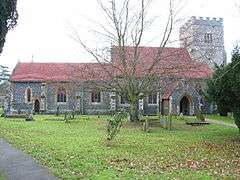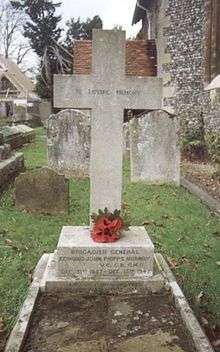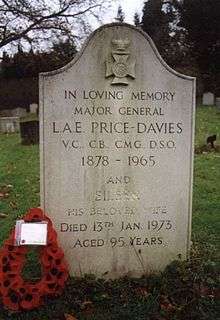Sonning
| Sonning | |
 St Andrew's Church |
|
 Sonning |
|
| Population | 1,445 (2001) 1,631 (2011 Census)[1] |
|---|---|
| OS grid reference | SU757755 |
| Civil parish | Sonning |
| District | Wokingham |
| Shire county | Berkshire |
| Region | South East |
| Country | England |
| Sovereign state | United Kingdom |
| Post town | READING |
| Postcode district | RG4 |
| Dialling code | 0118 |
| Police | Thames Valley |
| Fire | Royal Berkshire |
| Ambulance | South Central |
| EU Parliament | South East England |
| UK Parliament | Maidenhead |
Coordinates: 51°28′23″N 0°54′40″W / 51.473°N 0.911°W
Sonning is a village and civil parish in Berkshire, England, on the River Thames, east of Reading. The village was described by Jerome K. Jerome in his book Three Men in a Boat as "the most fairy-like little nook on the whole river".
Geography
The parish of Sonning originally included Charvil, Woodley and Earley and, before the formation of civil parishes in 1866, was a cross-county-boundary parish containing Sonning Eye, Dunsden Green and Playhatch in Oxfordshire as well. It is now much smaller and triangular shaped. The ecclesiastical parish of Sonning continues to include Sonning, Charvil and Sonning Eye. The north-western boundary is formed by the River Thames before passing through the middle of the Thames Valley Park. The southern border follows the railway line. The north-eastern boundary travels over Charvil Hill and follows the edge of the housing at Charvil itself until it reaches the confluence of St Patrick's Stream with the Thames, near St Patrick's Bridge. The northern corner of the parish consists of very low-lying land adjoining the River. The Sonning Golf Course sits in the south-east corner, with Holme Park, Sonning Hill and the business park in the south-west, and the village roughly in the middle.
Sonning village is at a crossing point of the River Thames, where the narrow arched Sonning Bridge on the B478 crosses the river to the hamlet of Sonning Eye on the Oxfordshire bank. Just upstream of the bridge is Sonning Lock. The old village is now joined to further housing along Pound Lane and the A4 Bath Road. It lies some three miles east of the major town of Reading. In other directions this would put it within the Reading suburban sprawl, but Sonning remains a clearly delineated small village.
Transport
- See also Sonning Lock
The main road through Sonning is the B478, running from the Bridge to the Charvil roundabout on the A4. The B4446 runs north from the A4 to the village. The A4 itself passes through the south of the parish, as does the main Reading to Paddington railway line, though there is no station. On the Thames, there are moorings at Sonning, both above and below the lock, as well as in the weir stream.
Local government
Sonning is a civil parish with an elected parish council of nine councillors. It falls within the area of the unitary authority of Wokingham. The parish council and the unitary authority are responsible for different aspects of local government.
Twinning
Sonning is twinned with Ligugé, France.[2] The village has an active Twinning Association and the lane to the village primary school is called Ligugé Way.
Toponomy
The place-name Sonning seems to contain an Old English personal name, Sunna, + ingas (Old English), The village of the people of . . . ; the village of the people called after . . .so probably, 'homestead/village of Sunna's people'.[3] Sonning appears in the Domesday survey of 1086 as Soninges.[4]
History

The historical name of the village is Sunning, derived from the name of the Old English Sunna.[5] Older, more traditional villagers still pronounce the name of the village in this way and the spelling can be found on old maps and documents. In Anglo-Saxon times, the village was of considerable importance as the lesser centre of the bishopric of Ramsbury, sometimes called the see of Ramsbury and Sonning. The church was a secondary cathedral and the present structure, St Andrew's Church, contains re-used Anglo-Saxon carvings. By the 12th century Sonning church had eight dependent churches, four of which had become independent parishes by the 15th century.[6] This is an example of the organisation of the Anglo-Saxon church into minsters with their own parochia known as the minster system.
Sonning prospered as an important stopping post for travellers, both by road and by boat. There were a number of ancient hostelries where they could have stayed, notably the Great House on the site of the original ferryman's cottage. The Bull Inn had the added bonus of being near the church where pilgrims could venerate a relic of Saint Cyriacus. The Bishops of Salisbury succeeded those of Ramsbury and Sonning and had a Bishop's Palace in the village until the 16th century. King Richard II's young bride, Queen Isabella of Valois, was kept captive there during his imprisonment and deposition.
Aberlash House is a Grade II listed house situated on an island in the River Thames at Sonning. It was originally built in the 17th century and formerly owned by the Rich family, Lords of the Manor of Sonning.
The Great Western Railway passes about half a mile south of the village, in a two-mile long cutting, Sonning Cutting. It was opened in 1840, and was the scene of one of the first railway disasters in 1841, when a goods train ran into a landslip. Nine passengers died in the accident, being thrown from the open trucks just behind the engine. Many were stonemasons working on the Houses of Parliament, and the disaster led to changes in the Railways Act, which required that third-class passengers be carried in stoutly constructed carriages rather than open trucks. The Act also created Parliamentary trains for third-class passengers.
Just outside the village, above Sonning Lock, is the independent secondary school, Reading Blue Coat School, in the 19th century manor house, Holme Park. Built in the 'Home Park' of the old palace, it replaced a Georgian mansion erected for the Lords of the Manor who eventually superseded the bishops. The first of these was Laurence Halstead, partner to the Reading cloth merchant, John Kendrick.
In the early 20th century, a second country house was built in the village, the Deanery. It provides a fine example of an Edwin Lutyens house with a Gertrude Jekyll garden, originally designed as a show house for the founder of Country Life magazine.
Notable residents



Notable former and current village inhabitants include:
- The Bishops of Ramsbury & Sonning, including SS Oda the Severe and Bertwald of Ramsbury
- The Bishops of Salisbury
- US General Dwight D. Eisenhower, before D-Day
- Neil Hamilton Fairley, Australian physician and soldier
- Anthony Farindon, 17th century Royalist preacher[7]
- Isabella of Valois, Queen consort of Richard II
- Uri Geller, the illusionist
- Laurence Halstead, 17th century cloth merchant and partner of philanthropist, John Kendrick[8]
- Glenn Hoddle, football manager and former footballer
- William Holman Hunt, the Pre-Raphaelite artist, in his later life at The Acre
- Ric Lee, drummer for the 1970s group Ten Years After
- Jon Lord, composer and founder member of the 1970s group Deep Purple[9]
- Right Honourable Theresa May, Prime Minister since 2016, is the local Member of Parliament
- Jimmy Page, lead guitarist of the rock group Led Zeppelin[10][11]
- Hugh Pearson, Victorian vicar of Sonning, later a Canon at Windsor
- Sir Terence Rattigan, dramatist, briefly at The Red House during 1945–47 – there is a blue plaque
- Sir Thomas Rich, 17th century merchant, money-lender to the King and benefactor to both Sonning and Gloucester
- Dick Turpin, reputedly, at his aunt's house, now called Turpins
- Admiral Villeneuve, subsequent to his defeat at the Battle of Trafalgar
- Robert Wright, 17th century Bishop of Lichfield & Coventry and vicar of Sonning
- George Clooney, American film star[12] In 2014, the Mill House in Sonning Eye, just over the River Thames from Sonning, was bought by the actor as a residence for him and his new British wife, the human rights lawyer Amal Clooney[13] at a cost of around £10 million.[14]
The following recipients of the Victoria Cross are buried in the churchyard of St Andrew's Church:
Sport and leisure
Sonning has a King George's Field in memorial to King George V, where Sonning Cricket Club[15] plays. There are playing fields between Sonning and the main A4 road, including hockey and rugby fields.
Sonning Hockey Club,[16] Reading Hockey Club, Reading R.F.C., and Berkshire Shire Hall R.F.C.[17] can all be found on Sonning Lane. Sonning Hockey Club was the first club in the county of Berkshire to be awarded Club 1st National Hockey Accreditation for junior coaching and development. Sonning Hockey Club also has squash courts and tennis courts.
Redingensians R.F.C. is nearby, off the Old Bath Road. Sonning Golf Club[18] is on the other side of the A4 road.
Sonning Regatta restarted in 2000 and is held every two years just upstream from Sonning Lock. There is sailing and waterskiing on the Caversham Lakes across the river and the Redgrave Pinsent Rowing Lake has recently been created there as well.
Sonning Parish Magazine,[19] established in 1869, serves Sonning and the neighbouring village of Charvil, and the Sonning Village Show is held every September at the village primary school.
Bibliography
- Angel Perkins, The Book of Sonning, Barracuda Books, 1977. ISBN 0-86023-051-1. 2nd edition, Baron Buckingham, 1999. ISBN 0-86023-051-1.
- Jonathan Bowen, Sonning-on-Wikipedia, Sonning Parish Magazine, page 26, October 2006.
References
- ↑ "Civil Parish population 2011". Neighbourhood Statistics. Office for National Statistics. Retrieved 1 December 2016.
- ↑ "British towns twinned with French towns". Archant Community Media Ltd. Retrieved 11 July 2013.
- ↑ M. Gelling The Place Names of Berkshire, 3 parts (Cambridge, 1973-6), i. pp.132-4, iii. pp.843-4; A.D.Mills, Dictionary of English Place-Names (Oxford, 2002), p.428; E.Ekwall, Concise Oxford Dictionary of English Place-names (Oxford, 1960), p.431; V.Watts, Cambridge dictionary of English place-names, (Cambridge,2004), p.560
- ↑ National Archives: E 31/2/1/1677
- ↑ Sonning, Royal Berkshire History.
- ↑ Pounds, Nigel (2000). A history of the English parish. Cambridge University Press. p. 22.
- ↑
 "Farindon, Anthony". Dictionary of National Biography. London: Smith, Elder & Co. 1885–1900.
"Farindon, Anthony". Dictionary of National Biography. London: Smith, Elder & Co. 1885–1900. - ↑ Ditchfield, P. H. and Page, William, eds. (1923). "Sonning with Earley, Woodley and Sandford". A History of the County of Berkshire: Volume 3. Victoria County History. pp. 210–225. Retrieved 5 September 2011.
- ↑ Didi Zill photo book.
- ↑ Jimmy Page now lives in Sonning, Berkshire Live, 19 July 2006.
- ↑ "Superstar among Sonning Scarecrows". BBC Berkshire. Retrieved 5 September 2011.
- ↑ http://www.telegraph.co.uk/news/celebritynews/11152701/George-Clooney-snaps-up-10-million-manor-house-in-Sonning-Berkshire.html
- ↑ Sawer, Patrick (10 October 2014). "Welcome to Sonning, Mr & Mrs Clooney". The Daily Telegraph. Retrieved 11 October 2014.
- ↑ Sawer, Patrick (9 October 2014). "George Clooney snaps up £10 million manor house in Sonning, Berkshire". The Daily Telegraph. Retrieved 11 October 2014.
- ↑ Sonning Cricket Club.
- ↑ Sonning Hockey Club.
- ↑ Berkshire Shire Hall R.F.C..
- ↑ Sonning Golf Club.
- ↑ Sonning Parish Magazine, Sonning Parish, United Kingdom.
External links
| Wikimedia Commons has media related to Sonning. |